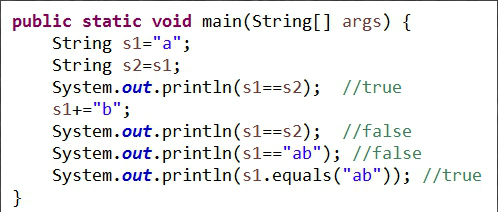一、
请运行以下示例代码StringPool.java,查看其输出结果。如何解释这样的输出结果?从中你能总结出什么?

答:定义的三个字符串如果相等,系统自动创建一个,并调用这个,对于由new创建的字符串,是开辟了一个新的空间,当直接使用new关键字创建字符串对象时,虽然值一致(都是“Hello”),但仍然是两个独立的对象空间之间不能直接向比较。
二、
为什么会有下述的输出结果?从中你又能总结出什么?

答:对于新开辟的两个空间对象,可以通过系统父类中的equals类直接进行比较。
编译器在编译s2一句时,会去掉“+”号,直接把两个字串连接起来得一个字串(“Hello”)。这种优化工作由Java编译器自动完成。
三、
请查看String.equals()方法的实现代码,注意学习其实现方法。
答:
public boolean equals(Object anObject) {
if (this == anObject) {
return true;
}
if (anObject instanceof String) {
String anotherString = (String)anObject;
int n = count;
if (n == anotherString.count) {
char v1[] = value;
char v2[] = anotherString.value;
int i = offset;
int j = anotherString.offset;
while (n-- != 0) {
if (v1[i++] != v2[j++])
return false;
}
return true;
}
}
return false;
}
四、
String类的方法可以连续调用:
String str="abc";
String result=str.trim().toUpperCase().concat("defg");
请阅读JDK中String类上述方法的源码,模仿其编程方式,编写一个MyCounter类,它的方法也支持上述的“级联”调用特性,其调用示例为:
MyCounter counter1=new MyCounter(1);
MyCounter counter2=counter1.increase(100).decrease(2).increase(3);
答:
想要实现“级联”调用,要在方法里创建对象,把返回值设成对象,从而返回的对象还可以再调用
代码如下
public class MyCounter
{
int data;
public MyCounter(int data)//构造方法
{
this.data=data;
}
public MyCounter()//空构造方法
{
}
public MyCounter increase(int d)//实现data加的方法,并返回对象
{
MyCounter a=new MyCounter();
a.data=data+d;
return a;
}
public MyCounter decrease(int d)// 实现data减的方法,并返回对象
{
MyCounter a=new MyCounter();
a.data=data-d;
return a;
}
public static void main(String[] args)
{
MyCounter counter1=new MyCounter(1);//创建对象counter1
MyCounter counter2=counter1.increase(100).decrease(2).increase(3);//创建对象counter2
System.out.println(counter2.data);//输出counter对象的data结果
}
}
五、
整理String类的Length()、charAt()、 getChars()、replace()、 toUpperCase()、 toLowerCase()、trim()、toCharArray()使用说明
答:
length():public int length()//求字符串长度
String s=”dwfsdfwfsadf”;
System.out.println(s.length());
charAt():public charAt(int index)//index 是字符下标,返回字符串中指定位置的字符
String s=”Hello”;
System.out.println(s.charAt(3));
getChars():public int getChars()//将字符从此字符串复制到目标字符数组
String str = "abcdefghikl";
Char[] ch = new char[8];
str.getChars(2,5,ch,0);
replace():public int replace()//替换字符串
String s=”\”;
System.out.println(s.replace(“\”,”///”));
结果///;
toUpperase():public String toUpperCase()//将字符串全部转换成大写
System.out.println(new String(“hello”).toUpperCase());
toLowerCse():public String toLowerCase()//将字符串全部转换成小写
System.out.println(new String(“HELLO”).toLowerCase());
trim():public String trim()
String x=”ax c”;
System.out.println(x.trim());//是去两边空格的方法
toCharArray(): String x=new String(“abcd”);// 将字符串对象中的字符转换为一个字符数组
char myChar[]=x.toCharArray();
System.out.println(“myChar[1]”+myChar[1])
.